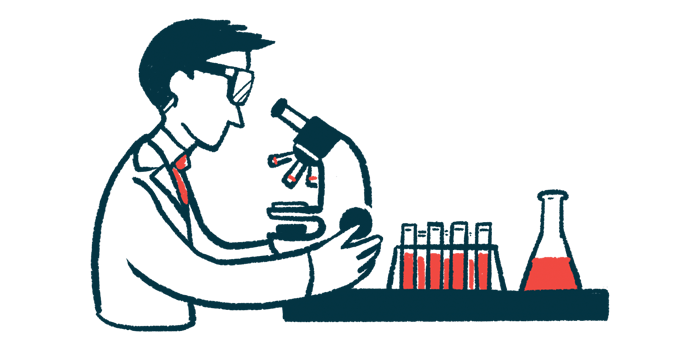Combined blood measure may detect biliary atresia in newborns
Markers from standard blood tests accurately detect condition in study

Combining the levels of two liver damage markers, obtained from standard blood tests, can accurately discriminate infants with biliary atresia from those without the disease, a study showed.
The newly created combined measure — levels of gamma-glutamyltransferase (GGT), a liver enzyme, multiplied by levels of direct bilirubin (D-bil), a waste product formed in the liver — showed a discriminating ability of 92%.
“We demonstrated that an easy parameter, “GGT∗D-bil” [higher than] 510 mg U/dL.L, may be used as part of the non-invasive cholestatic workups to assess the possibility of BA [biliary atresia] among cholestatic infants,” wrote the researchers, in Taiwan.
Cholestasis refers to slowed or stalled flow of bile, a digestive fluid transported from the liver to the intestines. Given that this condition can be a sign not only of biliary atresia, but also of other conditions, having an accurate way to identify biliary atresia may help improve outcomes for these infants.
The study, “Non-invasive simple predictors of biliary atresia in cholestatic infants – A preliminary report,” was published in Pediatrics & Neonatology.
Testing for biliary atresia in newborns
In biliary atresia, an infant’s bile ducts, the tubes that transport bile from the liver to the intestines, are blocked or missing. This leads to cholestasis and the buildup of bile in the liver, which disrupts its function and causes damage. This can ultimately result in liver failure and the need for a liver transplant.
Early detection, diagnosis, and surgical treatment to reestablish bile drainage are the gold standard for preventing the need for liver transplant in infants with biliary atresia. That means non-invasive tests suitable for newborns to establish the cause of cholestasis are essential.
“We need more modalities to serve as non-invasive parameters for the differential diagnosis of [biliary atresia] among cholestatic infants,” the researchers wrote.
With this in mind, the team developed a method to accurately detect biliary atresia among newborns with cholestasis using the results of standard blood tests.
The team started by retrospectively reviewing the medical records of 145 cholestatic infants, with a mean age of 43 days, who underwent testing at the National Taiwan University Hospital.
All underwent a standard battery of cholestatic tests, which included measuring blood levels of several liver damage markers, such as GGT, other liver enzymes, total bilirubin (T-bil), and D-bil.
GGT is considered to be a marker of blocked bile ducts. Bilirubin is an orange-yellow waste product normally converted in the liver to a form called conjugated, or direct, bilirubin, which is easily eliminated from the body. T-bil measures both unconjugated and conjugated bilirubin. When bile levels rise to toxic levels in the liver, the organ can’t process bilirubin, so it builds up in the bloodstream.
A total of 42 cholestatic infants (29%) were diagnosed with biliary atresia.
Blood markers show promise as predictor
The team found that infants with biliary atresia had significantly higher blood levels of D-bil and GGT, as well as a higher ratio of direct-to-total bilirubin (D/T-bil ratio), than those without the condition.
To amplify the predictive ability of such markers, the team created two new parameters: GGT∗D-bil, or GGT levels multiplied by D-bil levels, and GGT∗D/T-bil ratio, or GGT levels multiplied by the D/T-bil ratio. Values of both of these measures were significantly higher in the biliary atresia group than in the non-biliary atresia group.
Statistical analyses showed that a GGT∗D-bil value above 510 mg U/dL.L had the best predictive ability, being able to discriminate between infants with and without biliary atresia with an accuracy of 92%.
Its sensitivity, or ability to correctly identify patients with biliary atresia, was 100%, while its specificity, of ability to correctly identify those without biliary atresia, was 70.87%. Its negative predictive value (NPV), the probability that an infant with a negative test truly does not have biliary atresia, was also 100%.
The second-best predictor was a GGT∗D/T-bil ratio above 108 U/L, showing an overall accuracy of 91.3%.
To validate their findings, the researchers tested the diagnostic performance of these markers in 27 new cholestatic infants, who underwent testing at four other hospitals. Fourteen (52%) received a diagnosis of biliary atresia.
They researchers found that a GGT∗D-bil value above 510 mg U/dL.L showed an overall 75% accuracy at discriminating biliary atresia patients, with a sensitivity of 92.31%, specificity of 71.43%, and a NPV of 90.91%. D-bil levels above 2.90 mg/dL showed a sensitivity and NPV of 100% in the validation group.
“We demonstrated that the initial assessment with routine biochemistry in cholestatic infants may serve as a good screening parameter for the possibility of BA,” the researchers wrote. “The application of this easy and non-invasive parameter is not limited by the hospitals’ resources.”
Still, the team noted that the diagnostic potential of this parameter should be confirmed in larger studies involving infants in other geographic regions and of other ethnicities.








